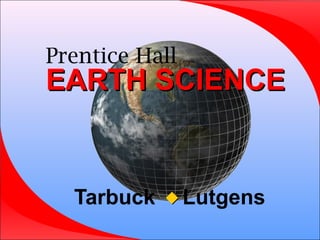
Prentice Hall Earth Science ch17 atmosphere
- 1. Prentice Hall EARTH SCIENCEEARTH SCIENCE Tarbuck Lutgens
- 2. Chapter 1717 The Atmosphere: Structure and Temperature
- 3. Composition of the Atmosphere 17.1 Atmosphere Characteristics Weather is constantly changing, and it refers to the state of the atmosphere at any given time and place. Climate, however, is based on observations of weather that have been collected over many years. Climate helps describe a place or region.
- 4. Composition of the Atmosphere 17.1 Atmosphere Characteristics Major Components • Air is a mixture of different gases and particles, each with its own physical properties.
- 5. Volume of Clean, Dry Air
- 6. Evolution of Earth’s Atmosphere • https://youtu.be/ocsV1cA4K4A
- 7. Composition of the Atmosphere 17.1 Atmosphere Characteristics Human Influence • Emissions from transportation vehicles account for nearly half the primary pollutants by weight.
- 8. Height and Structure of the Atmosphere 17.1 Atmosphere Characteristics The atmosphere rapidly thins as you get higher in altitude. • Atmospheric pressure is simply the weight of the air above. Pressure Changes
- 9. Atmospheric Pressure vs. Altitude
- 10. Layers of the Atmosphere 17.1 Atmosphere Characteristics Temperature Changes • The atmosphere can be divided into four layers based on temperature. 1. The tropospheretroposphere bottom layer up to 10 Km. Decreasing temperatures with height. 2. Where all WEATHER occurs. The stratospherestratosphere is from 10-50 Km. Increasing temperatures. 3. The mesospheremesosphere is from 50 to 80 Km. Decreasing temperatures with height. 4. The thermospherethermosphere is from 80 to 150 Km. Increasing temperatures due to solar energy. •
- 11. Snowy Mountaintops Contrast with Warmer Snow-Free Lowlands
- 12. Thermal Structure of the Atmosphere
- 14. Earth-Sun Relationships 17.1 Atmosphere Characteristics Earth’s Motions • Earth has two principal motions—rotation and revolution. Earth’s Orientation • Seasonal changes occur because Earth’s position relative to the sun continually changes as it travels along its orbit. 23231/21/2 degreedegree tilt on its axis produces 4 seasons.
- 15. Tilt of Earth’s Axis
- 16. Earth-Sun Relationships 17.1 Atmosphere Characteristics Solstices and Equinoxes • The autumnal equinox is the equinox that occurs on September 22 or 23 in the Northern Hemisphere. • The spring equinox is the equinox that occurs on March 21 or 22 in the Northern Hemisphere. • Equinox means EQUAL day & night.
- 17. Earth-Sun Relationships 17.1 Atmosphere Characteristics Solstices and Equinoxes • The summer solstice is the solstice that occurs on June 21 or 22 in the Northern Hemisphere and is the “official” first day of summer. • The winter solstice is the solstice that occurs on December 21 or 22 in the Northern Hemisphere and is the “official” first day of winter.
- 19. Energy Transfer as Heat 17.2 Heating the Atmosphere Radiation • Radiation is the transfer of energy (heat) through space by electromagnetic waves that travel out in all directions.
- 20. What Happens to Solar Radiation? 17.2 Heating the Atmosphere When radiation strikes an object, there usually are three different results. 1. Some energy is absorbed by the object. 2. Some radiation travels through substances such as water and air. 3. Some radiation may bounce off the object without being absorbed or transmitted.
- 21. Solar Radiation
- 22. What Happens to Solar Radiation? 17.2 Heating the Atmosphere • The greenhouse effectgreenhouse effect is the heating of Earth’s surface and atmosphere from solar radiation being absorbed and emitted by the atmosphere, mainly by water vapor and carbon dioxide. • An INCONVENIENT TRUTHINCONVENIENT TRUTH.
- 23. Why Temperatures Vary 17.3 Temperature Controls Altitude • The altitude can greatly influence temperatures experienced at a specific location. As altitude goes UP temperature goes DOWN.
- 24. Mean Monthly Temperatures for Guayaquil and Quito
- 26. So how can I find the relative humidity and the dewpoint? Easy. Just get youself a psychrometer. A psychrometer is just two thermometers. There’s a ‘dry bulb’ thermometer which just measures the temperature of the air in the room..... and there’s a ‘wet bulb’ thermometer whose bulb is surrounded by a cotton wick which is soaked with water. Great. So how does it work?
- 27. Water evaporates from the wet bulb. It takes 2260 Joules of heat energy to evaporate 1 gram of water (ESRT pg 1) That energy comes from the wet bulb itself. In other words, the evaporating water pulls heat energy away from the wet bulb leaving it cooler just the same way you are cooled when sweat evaporates from your skin. The more water that evaporates, the cooler the wet bulb. So what determines how much water evaporates? The relative humidity! The drier the air, the more water evaporates and the more the wet bulb is cooled. In other words, the drier the air, the greater the difference between the dry bulb and the wet bulb! f the relative humidity was 100% there would be NO evaporation and the wo thermometers would show the same temperature. No difference. 20o C 12o C
- 28. OK, now what? Now whip out your reference tables and turn to page 12...... According to our psychrometer (previous slide) the dry bulb is 20o C and the wet bulb is 12o C. Subtract to find the difference. 20 - 12 = 8 Find the dry bulb temperature (20o C) Find the difference (8o C) Now see where they meet....... The relative humidity is 36%. That’s all there is to it! OK, but how do you find the dewpoint?
Hinweis der Redaktion
- Who is Stan Hatfield and Ken Pinzke
- Makes no sense without caption in book
- Makes no sense without caption in book
- Makes no sense without caption in book
- Makes no sense without caption in book
- Makes no sense without caption in book
- Makes no sense without caption in book
- Makes no sense without caption in book
- Makes no sense without caption in book